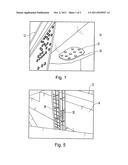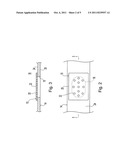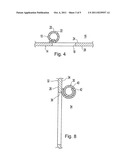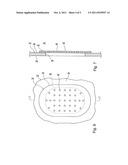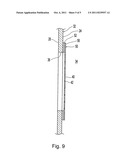Patent application title: MAGNETIC BIRD SCREEN
Inventors:
John M. Bowie (St. Marys, WV, US)
Matthew W. Lewellyn (Williamstown, WV, US)
Rodney D. Holbert (Mineral Wells, WV, US)
IPC8 Class: AE04B172FI
USPC Class:
52202
Class name: Static structures (e.g., buildings) auxiliary imperforate panel-like shield attached to main panel, barrier, or frame
Publication date: 2011-10-06
Patent application number: 20110239557
Abstract:
A magnetic bird screen for an access opening of a steel structure such as
a bridge or the like includes a magnetic sheet sized to cover the access
opening and overlap the steel structure entirely about the access opening
so that the sheet is magnetically secured to the steel structure. The
sheet has a plurality of spaced-apart holes sized sufficiently large to
permit the passage of air and water therethrough and sized sufficiently
small to prevent the passage of pigeons therethrough.Claims:
1. A screen for an access opening of a steel structure, said screen
comprising, in combination: a sheet sized to cover the access opening and
overlap the steel structure entirely about the access opening; wherein
the sheet has a plurality of spaced-apart holes sized sufficiently large
to permit the passage of air and water therethrough and sized
sufficiently small to prevent the passage of pigeons therethrough; and
wherein the sheet includes a magnetic portion for magnetically securing
the sheet to the steel structure.
2. The screen according to claim 1, wherein the magnet if portion is sized and shaped to extend entirely about the access opening.
3. The screen according to claim 1, wherein the sheet comprises a sheet magnet sized to cover the access opening and overlap the steel structure entirely about the access opening.
4. The screen according to claim 1, wherein the sheet is sufficiently flexible to be selectively rolled upon itself so that the sheet remains secured at one side of the access opening when it is desired to enter the access opening.
5. The screen according to claim 1, wherein the holes are about one inch in diameter.
6. The screen according to claim 1, wherein the overlap is in the range of about 1.75 inches to 5 inches.
7. A bridge comprising, in combination: a steel structure forming an enclosed space and having an access opening providing access to the enclosed space; a sheet sized to cover the access opening and overlap the steel structure entirely about the access opening; wherein the sheet has a plurality of spaced-apart holes sized sufficiently large to permit the passage of air and water therethrough and sized sufficiently small to prevent the passage of pigeons therethrough; and wherein the sheet includes a magnetic portion for magnetically securing the sheet to the steel structure.
8. The bridge according to claim 7, wherein the magnet if portion is sized and shaped to extend entirely about the access opening.
9. The bridge according to claim 7, wherein the sheet comprises a sheet magnet sized to cover the access opening and overlap the steel structure entirely about the access opening.
10. The bridge according to claim 7, wherein the sheet is sufficiently flexible to be selectively rolled upon itself so that the sheet remains secured at one side of at the access opening when it is desired to enter the access opening.
11. The bridge according to claim 7, wherein the holes are about one inch in diameter.
12. The bridge according to claim 7, wherein the overlap is in the range of about 1.75 inches to 5 inches.
13. The bridge according to claim 7, wherein the sheet is magnetically secured to a surface of the steel structure within the enclosed space.
14. A method for preventing birds from entering an access opening of steel a structure, said method comprising, in combination: obtaining a sheet sized to cover the access opening and overlap the steel structure entirely about the access opening; wherein the sheet has a plurality of spaced-apart holes sized sufficiently large to permit the passage of air and water therethrough and sized sufficiently small to prevent the passage of pigeons therethrough; and magnetically securing the sheet to the steel structure.
15. The method according to claim 14, wherein the obtaining step includes obtaining the magnetic portion sized and shaped to extend entirely about the access opening.
16. The method according to claim 14, wherein the obtaining step includes obtaining the sheet comprising a sheet magnet sized to cover the access opening and overlap the steel structure entirely about the access opening.
17. The method according to claim 14, wherein the obtaining step includes obtaining the sheet sufficiently flexible to be rolled upon itself
18. The method according to claim 17, further comprising the step of rolling the sheet upon itself so that the sheet remains secured at one side of the access opening when it is desired to enter the access opening.
19. The method according to claim 18, wherein the sheet is magnetically secured to a surface of the steel structure within the enclosed space.
20. The method according to claim 14, wherein the step of magnetically securing includes magnetically securing the sheet to a surface of the steel structure within the enclosed space.
Description:
CROSS-REFERENCE TO RELATED APPLICATIONS
[0001] Not Applicable
STATEMENT REGARDING FEDERALLY SPONSORED RESEARCH
[0002] Not Applicable
REFERENCE TO APPENDIX
[0003] Not Applicable
FIELD OF THE INVENTION
[0004] The field of the present invention generally relates to devices for preventing bird intrusion and, more particularly, devices for preventing birds from entering enclosed spaces in bridge structures.
BACKGROUND OF THE INVENTION
[0005] Pigeons, and droppings cause by the pigeons, is a constant menace to bridge inspectors and bridge maintenance crews. Some bridge steel members or structures such as, for example, box beams have interior spaces that are enclosed except for access openings. The access openings are provided so that bolts can be tightened on the interior sides and/or bridge inspectors can look inside for signs of fatigue cracks etc.
[0006] These access openings can also be used by pigeons to get inside the steel members and build nests. With pigeons in the bridge come heavy amounts of droppings. The pigeon droppings can be corrosive to the metal and can obscure surfaces that need to be inspected. As a result, bridges need to be cleaned before they can be adequately inspected. The cleaning of a bridge alone can be very expensive.
[0007] Several methods have been used to keep pigeons from accessing interior portions of steel members. One method is to bolt metal covers over the access openings. However, it is time consuming to remove and reinstall the covers for each inspection. As a result, the cost can be nearly as much as cleaning the bridge. Another method is to clip plastic covers over the access openings. For example, see U.S. Pat. No. 5,209,032, the disclosure of which is expressly incorporated herein in its entirety by reference. However, these plastic covers are slightly less time consuming and expensive to remove and reinstall for each inspection. In fact some people have wondering if plastic covers limited the views of inspectors prior to the collapse of the I-35W Mississippi River bridge in Minneapolis, Minn. in 2007. Accordingly, there is a need for improved devices and methods for keeping pigeons out of the interior portions of steel members.
SUMMARY OF THE INVENTION
[0008] Disclosed are methods and devices for covering access opening of steel structures which address one or more issues of the related art. One disclosed embodiment is a screen for an access opening of a steel structure. The screen comprises a sheet sized to cover the access opening and overlap the steel structure entirely about the access opening. The sheet has a plurality of spaced-apart holes sized sufficiently large to permit the passage of air and water therethrough and sized sufficiently small to prevent the passage of pigeons therethrough. The sheet includes a magnetic portion for magnetically securing the sheet to the steel structure.
[0009] Another disclosed embodiment is a bridge comprising, in combination: a steel structure forming an enclosed space and having an access opening providing access to the enclosed space, and a sheet sized to cover the access opening and overlap the steel structure entirely about the access opening. The sheet has a plurality of spaced-apart holes sized sufficiently large to permit the passage of air and water therethrough and sized sufficiently small to prevent the passage of pigeons therethrough. The sheet includes a magnetic portion for magnetically securing the sheet to the steel structure.
[0010] A further disclosed embodiment is method for preventing birds from entering an access opening of steel a structure. The method comprises, in combination, obtaining a sheet sized to cover the access opening and overlap the steel structure entirely about the access opening, and magnetically securing the sheet to the steel structure. The sheet has a plurality of spaced-apart holes sized sufficiently large to permit the passage of air and water therethrough and sized sufficiently small to prevent the passage of pigeons therethrough.
[0011] From the foregoing disclosure and the following more detailed description of various preferred embodiments it will be apparent to those skilled in the art that the present invention provides a significant advance in the technology and art of bird screens for access openings of steel structures. Particularly significant in this regard is the potential the invention affords for providing a low cost, easily removed and reinstalled screen which prevents birds from entering access openings of steel structures. Additional features and advantages of various preferred embodiments will be better understood in view of the detailed description provided below.
BRIEF DESCRIPTION OF THE DRAWINGS
[0012] These and further features of the present invention will be apparent with reference to the following description and drawings, wherein:
[0013] FIG. 1 is a perspective view of a portion of a bridge having a bird screen covering an access opening according to a first embodiment of the present invention;
[0014] FIG. 2 is a top plan view of the bird screen of FIG. 1, wherein portions of the steel members have been removed for clarity;
[0015] FIG. 3 is a sectional view taken along line 3-3 of FIG. 2;
[0016] FIG. 4 is a sectional view similar to FIG. 3 but wherein the magnetic bird screen is in a retracted configuration;
[0017] FIG. 5 is a perspective view of a portion of a bridge having a bird screen covering an access opening according to a second embodiment of the present invention;
[0018] FIG. 6 is a top plan view of the bird screen of FIG. 5, wherein portions of the steel members have been removed for clarity;
[0019] FIG. 7 is a sectional view taken along line 7-7 of FIG. 6;
[0020] FIG. 8 is a sectional view similar to FIG. 7 but showing the bird screen in a retracted configuration; and
[0021] FIG. 9 is a sectional view similar to FIG. 7 but showing a variation of the bird screen wherein the separate magnetic and screen layers are provided.
[0022] It should be understood that the appended drawings are not necessarily to scale, presenting a somewhat simplified representation of various preferred features illustrative of the basic principles of the invention. The specific design features of the bird screens as disclosed herein, including, for example, specific dimensions, orientations, locations, and shapes of the various components, will be determined in part by the particular intended application and use environment. Certain features of the illustrated embodiments have been enlarged or distorted relative to others to facilitate visualization and clear understanding. In particular, thin features may be thickened, for example, for clarity or illustration. All references to direction and position, unless otherwise indicated, refer to the orientation of the insulated carriers illustrated in the drawings. In general, up or upward generally refers to an upward direction within the plane of the paper in FIGS. 1 and 5 and down or downward generally refers to a downward direction within the plane of the paper in FIGS. 1 and 5.
DETAILED DESCRIPTION OF CERTAIN PREFERRED EMBODIMENTS
[0023] It will be apparent to those skilled in the art, that is, to those who have knowledge or experience in this area of technology, that many uses and design variations are possible for the improved bird screens disclosed herein. The following detailed discussion of various alternative and preferred embodiments will illustrate the general principles of the invention. Other embodiments suitable for other applications will be apparent to those skilled in the art given the benefit of this disclosure.
[0024] Referring now to the drawings, FIGS. 1 to 4 show a magnetic bird screen 10 installed on a bridge 12 according to a first embodiment of the present invention. The illustrated bridge 12 includes a steel member or structure 14 forming an enclosed interior space 16 and having an access opening 18 providing access to the enclosed interior space 16 within the steel member 14. The illustrated steel member 14 is a horizontally extending box beam but it is noted that the steel member 14 can alternatively be other types of steel members and/or the steel member 14 can alternatively be vertically extending or inclined. The illustrated access opening 18 is located in a horizontal plate at the bottom of the steel member 14. It is noted, however, that the access opening 18 can alternatively be located at any other suitable side of the steel member 14. The illustrated access opening 18 has a length of about 12 inches and width of about 8 inches and has rounded ends but it is noted that the access opening 18 can alternatively have any other suitable size and/or shape.
[0025] The illustrated magnetic bird screen 10 includes a sheet 20 sized to entirely cover the access opening 18 and to overlap the steel member 14 entirely about the periphery of the access opening 18. The illustrated sheet 20 is rectangular shaped and generally planar having a length of about 16 inches and a width of about 111/2 inches. It is noted however that the sheet 20 can alternatively have any other suitable size and/or shape. Sized in this manner, the sheet 20 overlaps the steel structure form about 13/4 inches to about 2 inches around the access opening 18. The illustrated sheet 20 is thin enough so that it is sufficiently flexible to be selectively rolled upon itself. Rolled in this manner, the sheet 20 can remain secured at one side of the access opening 18 when it is desired to enter the access opening 18 (best shown in FIG. 4).
[0026] The illustrated sheet 20 has a plurality of spaced-apart holes 22 sized sufficiently large to permit the passage of air and water therethrough and sized sufficiently small to prevent the passage of pigeons therethrough. The illustrated holes 22 are circular and have a diameter of about 1 inch but it is noted that any other suitable size and/or shape can alternatively be utilized. The illustrated sheet 20 includes eleven of the holes 22 but it is noted that any other suitable quantity of the holes 22 can alternatively be utilized. It should be appreciated that a larger size and/or quantity of the holes 22 reduces pressure formed on the magnetic bird screen 10 by wind and/or water engaging the magnetic bird screen 10 from the environment.
[0027] The illustrated sheet 20 is entirely formed by a sheet magnet so that the sheet magnet entirely covers the access opening 18 and overlaps the steel structure 14 entirely about the access opening 18. Formed in this manner, the sheet 20 is magnetically secured to the steel structure 14 entirely about the access opening 18. The sheet magnet can comprise any suitable type of magnetic material which will provide suitable attraction to the steel member 14 and withstand the natural elements at the location of the steel member 14. Suitable sheet magnet material is available from the Mangum Magnetics Corporation of Marietta, Ohio. It is noted that the magnetic sheet can alternatively form less than the entire sheet 20 as described in more detail hereinafter.
[0028] To close the access opening 18, the magnetic bird screen 10 is placed entirely over the access opening 18 so that it is magnetically secured to the steel member 14 entirely about the periphery of the access opening 18. Secured in this manner, birds such as pigeons cannot enter and nest in the interior space 16 of the steel member 14 through the access opening 18. The magnetic bird screen 10 is preferably secured to an inner surface 24 of the steel member 14 so that the magnetic bird screen 10 is located with the enclosed interior space 16 so that the magnetic bird screen 10 is likely to be retained by the steel member 14 if the magnetic bird screen 10 is unexpectedly dislodged form the steel member 14. It is noted, however, that the magnetic bird screen 10 can alternatively be secured to an outer surface 26 of the steel member 14 so that the magnetic bird screen 10 is located on the outside of the steel member 14 but the magnetic bird screen 10 may fall if the magnetic bird screen 10 is unexpectedly dislodged form the steel member 14. As best shown in FIG. 4, when it is desired to gain access through the access opening 18, the magnetic bird screen 10 can be easily rolled upon itself toward one end of the access opening 18 to a retracted configuration. Rolled in the manner, the magnetic bird screen 10 can remain magnetically secured to the steel member 14 at the end of the access opening 18 while an inspector or the like gains access through the access opening 18. When access through the access opening 18 is no longer desired, the magnetic bird screen 10 is rolled back to its extended configuration to entirely cover the access opening 18. This process can be quickly and easily accomplished without the need for tools.
[0029] Referring now to the drawings, FIGS. 2 to 8 show a magnetic bird screen 30 installed on the bridge 12 according to a second embodiment of the present invention which is substantially the same as the first embodiment described hereinabove. The illustrated bridge 12 includes another steel member or structure 32 forming an enclosed interior space 34 and having an access opening 36 providing access to the enclosed interior space 34 within the steel member 32. The illustrated steel member 32 is a horizontally extending box beam but it is noted that the steel member 32 can alternatively be other types of steel members and/or the steel member 32 can alternatively be vertically extending or inclined. The illustrated access opening 36 is located in a vertical plate at lateral side of the steel member 32 and is provided with an access ladder 38 located along the side of the steel member. It is noted, however, that the access opening 36 can alternatively be located at any other suitable side of the steel member 32. The illustrated access opening 36 has a length of about 30 inches and width of about 20 inches and has rounded ends but it is noted that the access opening 36 can alternatively have any other suitable size and/or shape.
[0030] The illustrated magnetic bird screen 30 includes a sheet 40 sized to entirely cover the access opening 36 and to overlap the steel structure 14 entirely about the periphery of the access opening 36. The illustrated sheet is rectangular shaped with rounded ends and generally planar having a length of about 40 inches and a width of about 25 inches. It is noted however that the sheet 40 can alternatively have any other suitable size and/or shape. Sized in this manner, the sheet 40 overlaps the steel structure 32 form about 21/2 inches to about 5 inches around the access opening 36. The illustrated sheet 20 is thin enough so that it is sufficiently flexible to be selectively rolled upon itself. Rolled in this manner, the sheet 40 can remain magnetically secured at one side of the access opening 36 when it is desired to enter the access opening 36 (best shown in FIG. 8).
[0031] The illustrated sheet 40 has a plurality of spaced-apart holes 42 sized sufficiently large to permit the passage of air and water therethrough and sized sufficiently small to prevent the passage of pigeons therethrough. The illustrated holes 42 are circular and have a diameter of about 1 inch but it is noted that any other suitable size and/or shape can alternatively be utilized. The illustrated sheet 40 includes thirty three of the holes 42 but it is noted that any other suitable quantity of the holes 42 can alternatively be utilized. It should be appreciated that a larger size and/or quantity of the holes 42 reduces the pressure formed on the magnetic bird screen 30 by wind and/or water engaging the magnetic bird screen 30.
[0032] The illustrated sheet 40 is entirely formed by a sheet magnet so that the sheet magnet entirely covers the access opening 36 and overlaps the steel structure 32 entirely about the access opening 36. Formed in this manner, the sheet 40 is magnetically secured to the steel structure 32 entirely about the access opening 36. The sheet magnet can comprise any suitable type of magnetic material which will provide suitable attraction to the steel member 32 and withstand the natural elements at the location of the steel member 32. Suitable sheet magnet material is available from the Mangum Magnetics Corporation of Marietta, Ohio. It is noted that the magnetic sheet can alternatively form less than the entire sheet 40 as described in more detail hereinafter.
[0033] FIG. 9 shows a magnetic bird screen 50 which is substantially the same as the magnetic bird screen 30 described hereinabove and like reference numbers are utilized to identify like structure. The magnetic bird screen 50 has a sheet 40 that only a portion of which is magnetic. The illustrated sheet 50 has two separate layers. A first or magnetic layer 52 is a magnetic sheet sized to generally cover the entire overlap between the sheet 40 and the steel member 32. The illustrated magnetic layer has 52 a central opening 54 generally sized to match the access opening 36 but the central opening can alternatively be of any other suitable size. It is noted that the magnetic layer 52 can be formed by one or more segments of the magnetic sheet. A second or nonmagnetic layer 56 covers the central opening 54 in the magnetic layer 52 so that the entire access opening 36 is covered by the sheet 40. The nonmagnetic layer 56 can be of any suitable material such as, for example, metal, plastic, or the like and can be in any suitable form such as a sheet, net, or the like. The nonmagnetic layer 56 is preferably made of a material suitable for the environmental conditions and should be sufficiently flexible so that the magnetic bird screen 50 can be rolled upon itself as described hereinabove. The nonmagnetic layer 52 can be secured to the magnetic layer 52 in any suitable manner such as, for example, adhesive, mechanical fasteners, or the like.
[0034] Any of the features or attributes of the above the above described embodiments and variations can be used in combination with any of the other features and attributes of the above described embodiments and variations as desired.
[0035] It is apparent from the above detailed description of preferred embodiments of the present invention, that magnetic bird screens 10, 30, 50 of the present invention effectively close access openings to prevent entry of birds such as pigeons and are relatively inexpensive to produce. The magnetic bird screens 10, 30, 50 of the present invention can also be quickly and easily installed, removed, and reinstalled without the need for tools.
[0036] From the foregoing disclosure and detailed description of certain preferred embodiments, it is also apparent that various modifications, additions and other alternative embodiments are possible without departing from the true scope and spirit of the present invention. The embodiments discussed were chosen and described to provide the best illustration of the principles of the present invention and its practical application to thereby enable one of ordinary skill in the art to utilize the invention in various embodiments and with various modifications as are suited to the particular use contemplated. All such modifications and variations are within the scope of the present invention as determined by the appended claims when interpreted in accordance with the benefit to which they are fairly, legally, and equitably entitled.
User Contributions:
Comment about this patent or add new information about this topic:
| People who visited this patent also read: | |
| Patent application number | Title |
|---|---|
| 20190049279 | CALIBRATION SYSTEM INCLUDING SEPARATION VESSEL AND PIPELINE |
| 20190049278 | THERMAL TYPE FLOWMETER |
| 20190049276 | INSERTION ULTRASONIC SENSOR ASSEMBLY |
| 20190049275 | METHOD, A CIRCUIT AND A SYSTEM FOR ENVIRONMENTAL SENSING |
| 20190049274 | APPARATUS AND SYSTEM FOR BUILDING MONITORING |

